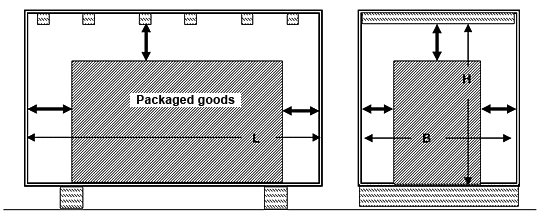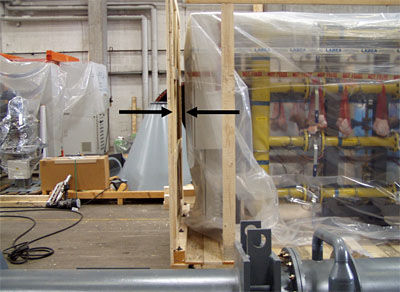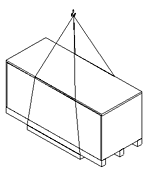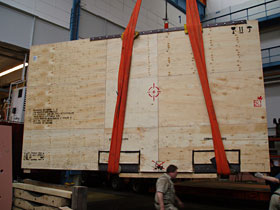Boxes and crates are generally load-bearing packaging. They are designed in such a way that they carry the entire weight of the packaged goods during handling. The lifting equipment (loading tackle, ground conveyors) is attached to the package, which means that load-bearing packaging is subject to higher loads during handling than accompanying packaging. The following requirements apply to load-bearing packaging:
Figure 45: Schematic diagram of a load-bearing box (left), load-bearing packaging Because their construction is almost identical, boxes and crates will be considered together as load-bearing packaging. The construction of crates is the same as for cut-lumber boxes, with the exception of the arrangement of the cladding, which does not form a closed surface in the case of crates. For this reason, the following discussion will concentrate primarily on boxes as examples. Attention will be drawn to any particular issues that need to be taken into account for crates. In the field of heavy cargo, boxes and crates are generally "tailored packaging". The size and dimensional design of such packaging are tailored to the goods to be packaged, which means that the packaging is produced individually for the goods concerned. Measurements have to be taken for each item of packaging. Depending on the dimensions of the packaged goods and the necessary safety clearance between the packaged goods and the interior surfaces of the packaging, these measurements determine the internal dimensions. These internal dimensions are specified in centimeters in the sequence length ("L"), width ("W") and height ("H"). The following principles apply when determining the internal dimensions of the packaging container: The internal dimensions of boxes/crates are measured between the opposing side, floor and lid components of the box/crate. The internal dimensions must be sufficient to allow an adequate safety clearance between the packaged goods and the wall/lid elements. 6.1.1 Safety clearance between packaging and packaged goods The safety clearance between the packaged goods and the packaging container should not be smaller than 3 cm, and when the desiccant or VCI anticorrosion methods are used, it should be at least 5 cm in order to protect the film cover.

Figure 46: Schematic illustration of safety clearances with boxes and crates 
Figure 47: Safety clearance between packaged goods and the wall of the box |
| Top of pageContents |


